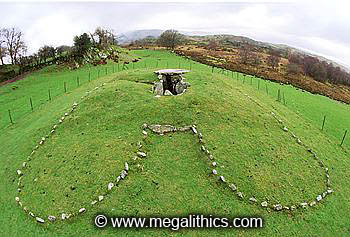
 |
|
More Pics |
|
|
Panoramas |
|
| SH 81797 54328 (GPS 32min) | |
| Visited March 2002 |
Capel Garmon is a Cotswold-Severn cairn of the "Breconshire" sub-type. This class of cairn is typified as having lateral chambers with differentiated structure, and a false or blind entrance at the "front" between the forecourt horns. What makes Capel Garmon unusual is its location here in Gwynedd.
Breconshire variant Cotswold-Severn cairns are usually found further south, particularly in the Usk valley in a region around Talgarth, very few exist outside of this region. It is thought that Capel Garmon was constructed by an isolated migrant community which retained its southern traditions.
It is likely that they had very limited interaction with the surrounding culture as there are no traces of their influence in the structure of other local tombs, and no sign of local influences in the structure of Capel Garmon itself.
The bulk of the cairn at Capel Garmon has been robbed away, but enough remains to see that it was of the classic trapezoid shape with a horned forecourt. Today, the original limits of the cairn have been picked out with a outline of small stones, although the nature of the local topography makes it difficult to get an overall view of the
cairn and chambers from ground level. The cairn is about 27m long and about 15m across at its widest, with a simple blind entrance consisting of two upright slate slabs between the horns of the forecourt, the real chamber entrance is halfway along the southern side of the cairn.
The internal layout is "T" shaped, with circular chambers at the east and west ends of the crossbar.
The entrance passage is 4m long and was originally roofed by corbelling, the walls, like those of the entire interior, consist of large spaced orthostats with dry-stone interfill. During excavation, it was found that the southern end of the passage had been completely filled with blocking material.
The end of the passage is slightly constricted by jamb-like stones and opens into a rectangular area of about 2m by 3m, two roughly circular chambers open off this space at the east and west. This large area may be considered as a chamber in its own right, it is partially divided by slabs built out from the north wall which, together with the northern jamb of the western chamber, form a kind of "stall".
The western chamber is about 3m in diameter and retains its capstone, although this is now supported on two modern beams. A large hole has been made in the west wall of the chamber and this is now the most convenient access to the chambers as the original entrance passage has been walled off. We were sad to see that the walls of this chamber have been defaced with recent
graffiti in Welsh. The eastern chamber is roofless but has intact walls, it is about the same diameter as the western chamber. Both chambers have jamb stones at their entrances, but there was no evidence of sill stones.
A limited excavation in 1927 produced few finds, all coming from the entrance passage. One sherd of Ebbsfleet ware and two of Beaker pottery were uncovered, along with a flint flake. Interestingly, the Ebbsfleet ware pot had some similarities to pottery found at
Nympsfield, a transepted Cotswold-Severn cairn in Gloucestershire, providing further linkage of Capel Garmon to the Cotswold-Severn group.
Although there were no directly dateable finds at Capel Garmon, other Cotswold-Severn cairns with lateral chambers have been carbon dated to about 3500calBC, their introduction is thought to have been 2-300 years earlier than the
cairns with axial chambers.